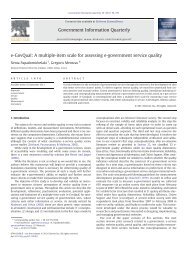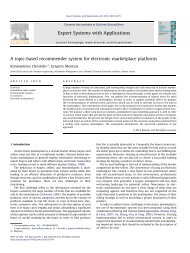Ontology-Based Competency Management for Corporate E-Learning
Ontology-Based Competency Management for Corporate E-Learning
Ontology-Based Competency Management for Corporate E-Learning
Create successful ePaper yourself
Turn your PDF publications into a flip-book with our unique Google optimized e-Paper software.
<strong>Ontology</strong>-<strong>Based</strong> <strong>Competency</strong> <strong>Management</strong> <strong>for</strong> <strong>Corporate</strong> E-<strong>Learning</strong> 321<br />
als identified earlier as superior, effective, and marginal per<strong>for</strong>mers are rated on this<br />
questionnaire by multiple individuals, if possible, such as managers, peers, and direct<br />
reports. The ratings on the competency questionnaire are correlated to the per<strong>for</strong>mance<br />
ratings to determine if each competency relates to job per<strong>for</strong>mance.<br />
• Finalize the model: The last step involves eliminating any competencies that do not<br />
correlate with the per<strong>for</strong>mance measures to provide a validated model that is linked<br />
to effective per<strong>for</strong>mance.<br />
C] Employees’ <strong>Competency</strong> Assessment<br />
The assessment of the competencies that each employee possesses, as well as of the level that<br />
each competency is possessed, is crucial to the success of the whole project. Only through<br />
correct evaluation will the system be able to per<strong>for</strong>m an accurate skill gap analysis and all<br />
the other human resources functions that are based on it, such as creating a personalized<br />
learning path <strong>for</strong> employees’ development, defining training needs, per<strong>for</strong>ming succession<br />
planning, and more.<br />
What we suggest as the best approach to a successful competency assessment of employees<br />
is a combination of 360-degree feedback and per<strong>for</strong>mance review. In more detail, a questionnaire<br />
about an employee’s behaviors should be replied to by the employee herself, her peers,<br />
her manager, her team members, and possibly from people outside the company. Then, the<br />
results collected should be weighted based on different factors–<strong>for</strong> example, the number of<br />
years that each of the responders has collaborated with the assessed employee. This initial<br />
assessment should be validated and fine-tuned, using the results of the employee’s per<strong>for</strong>mance<br />
review. For example, if an employee has received a good score on a per<strong>for</strong>mance<br />
review metric because several members of her team have been promoted, it is highly likely<br />
that she possesses the competency of “developing people” at a high level, but this has to be<br />
crosschecked and validated with the results of the 360-degree feedback.<br />
D] Correlation of the <strong>Competency</strong> <strong>Ontology</strong> with the <strong>Learning</strong> Object <strong>Ontology</strong><br />
The competency management system that has been described above, after per<strong>for</strong>ming the<br />
skill gap analysis of an employee, provides her with a personalized learning path in order<br />
to increase the level of possessed competencies or acquire additional ones. The successful<br />
implementation of this function depends on the correct correlation of the competency ontology<br />
with the learning object ontology. Ideally, each competency level should be related<br />
to one or more learning objects that are appropriate only to the specific competency level,<br />
thus facilitating the learning process and not providing the employees with learning objects<br />
that are too hard or to easy <strong>for</strong> her competency levels. To eliminate this possibility, feedback<br />
should be collected by employees who master certain competencies, on the competency<br />
level that each learning object should be assigned. This subjective correlation of competency<br />
levels with learning objects has proven the only efficient way to validate this process, even<br />
<strong>for</strong> learning objects with predefined competency level—<strong>for</strong> example, a technical seminar<br />
predefined as level 200/500.<br />
Copyright © 2007, Idea Group Inc. Copying or distributing in print or electronic <strong>for</strong>ms without written permission<br />
of Idea Group Inc. is prohibited.





